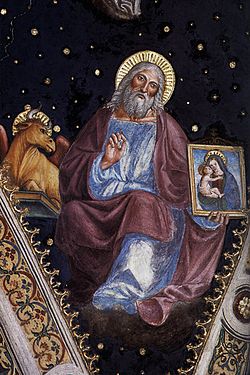
Santi Quattro Coronati is an ancient basilica in Rome, Italy. The church dates back to the fourth or fifth century, and is devoted to four anonymous saints and martyrs. The complex of the basilica with its two courtyards, the fortified Cardinal Palace with the Saint Silvester Chapel, and the monastery with its cosmatesque cloister is built in a silent and green part of Rome, between the Colosseum and San Giovanni in Laterano, in an out-of-time setting.

The Certosa di Pavia is a monastery and complex in Lombardy, Northern Italy, situated near a small town of the same name in the Province of Pavia, 8 km (5.0 mi) north of Pavia. Built in 1396–1495, it was once located on the border of a large hunting park belonging to the Visconti family of Milan, of which today only scattered parts remain. It is one of the largest monasteries in Italy.

San Cristoforo sul Naviglio is a church in Milan, northern Italy.

Aurelio Luini was an Italian painter and draughtsman from Milan, the fourth and last son of Bernardino Luini. A representative of late Lombard Mannerism, he was a friend of Gian Paolo Lomazzo.
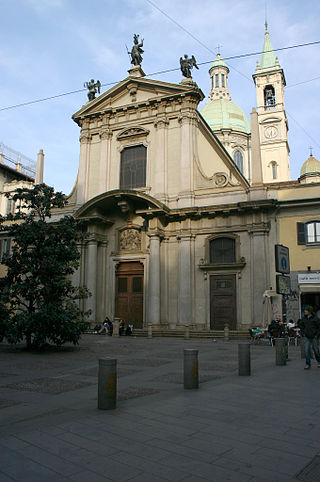
San Giorgio al Palazzo is a baroque-style, Roman Catholic church in central Milan, region of Lombardy, Italy.

San Paolo Converso is a former Roman Catholic church in Milan, region of Lombardy, Italy, now utilized as a contemporary art space.

The Abbey of Monte Oliveto Maggiore is a large Benedictine monastery in the Italian region of Tuscany, 10 km south of Asciano. Its buildings, which are mostly of red brick, are conspicuous against the grey clayey and sandy soil—the Crete senesi which give this area of Tuscany its name.

The Abbey of Santa Maria di Rovegnano is a Cistercian monastic complex in the comune of Milan, Lombardy, northern Italy. The borgo that has developed round the abbey was once an independent commune called Chiaravalle Milanese, now included in Milan and referred to as the Chiaravalle district.

San Benedetto is a late-Baroque architecture, Roman Catholic church and former Benedictine monastery in the city Catania, Sicily, southern Italy. The church facade faces Via Crociferi, parallels across via San Benedetto the former-Jesuit church of San Francesco Borgia, and both are about a block south along Crociferi from the church and convent of San Giuliano. Entrance to church and monastery appear to be through Piazza Asmundo #9 near the apse of the church.

The church and monastery of San Vittore al Corpo were an ancient monastery of the Olivetan order built in the early 16th century. The site was once a fourth century Roman imperial mausoleum of Maximian, that may also have held the burials of the emperors Gratian and Valentinian II, though they were more likely buried in another mausoleum, now the Chapel of Saint Aquilinus in the Basilica of Saint Lawrence. The basilica was enlarged in the 8th century to house the relics of the saints Vittore and Satiro. A Benedictine monastery soon was attached to the church. In 1507, the monastery was transferred to the Olivetans, who began a major reconstruction. Reconstruction of the church was begun in 1533 by Vincenzo Seregni, and completed in 1568 by Pellegrino Tibaldi. The façade remains incomplete. The dome was frescoed in 1617 by Guglielmo Caccia. In the chapel of St Anthony is a 1619 canvas by Daniele Crespi. In the transept on the left, is an early 17th-century cycle of canvases of the Stories of San Benedetto, by Ambrogio Figino while the right transept has three altarpieces by Camillo Procaccini. Other chapels have paintings by Pompeo Batoni and Giovanni Battista Discepoli.
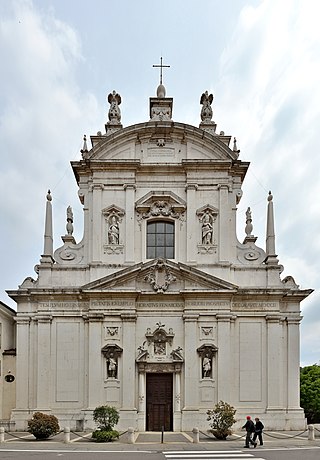
The church of Saints Faustinus and Jovita, also known as the church of San Faustino Maggiore, is a church in Brescia, located on the street of the same name, Via San Faustino, along the last stretch to the north. It is the patron church of the city of Brescia and, for this reason, it is the most important religious building in the city after the cathedrals, the Old Cathedral and the New Cathedral.
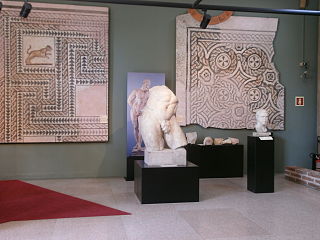
The Archaeological Museum of Milan is located in the ex-convent of the Monastero Maggiore, alongside the ancient church of San Maurizio al Monastero Maggiore, with entrance on Corso Magenta.

The church of Santi Severino e Sossio and the annexed monastery are located on via Bartolommeo Capasso in Naples, Italy.
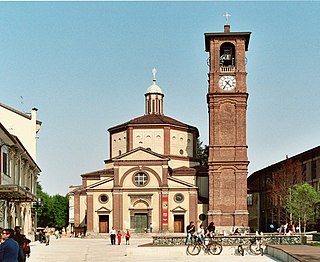
The Basilica of Saint Magnus is the principal church of the Italian town of Legnano, in the province of Milan. It is dedicated to the Saint Magnus, who was Archbishop of Milan from 518 to 530. The church was built from 1504 to 1513 in the Renaissance-style designed by Donato Bramante. The bell tower was added between the years 1752 and 1791. On 18 March 1950, Pope Pius XII named the Basilica of San Magno a minor basilica.

The Church of Our Lady of the Graces is a Gothic-style, Roman Catholic church in Varallo Sesia, province of Vercelli, region of Piedmont, Italy. The church was built, together with the adjacent Franciscan convent, by padre Bernardo Caimi between 1486 and 1493. At this time, the construction of the Sacro Monte was also beginning. In December 1931, Pope Pius XI gave the church the title of Minor Basilica.

The Basilica of Santissimo Salvatore is a Roman Catholic church in Pavia, region of Lombardy, Italy. It was founded in 657 by the Lombard king Aripert I and became a mausoleum for many of the Lombard kings.

The monastery of San Felice was one of the main female Benedictine monasteries of Pavia; founded since the Lombard period, it was suppressed in the 18th century.Part of the church and the crypt survive from the original Lombard complex.

The church of San Marino is a Catholic church in Pavia, in Lombardy.

The Church of San Tommaso is a former Catholic church and monastery in the city of Pavia, Lombardy, Italy. It is located within the historic city center and belongs to the University of Pavia.

The monastery of Santa Maria Teodote, also known as Santa Maria della Pusterla, was one of the oldest and most important female monasteries in Pavia, Lombardy, now Italy. Founded in the seventh century, it stood in the place where the diocesan seminary is located and was suppressed in the eighteenth century.




